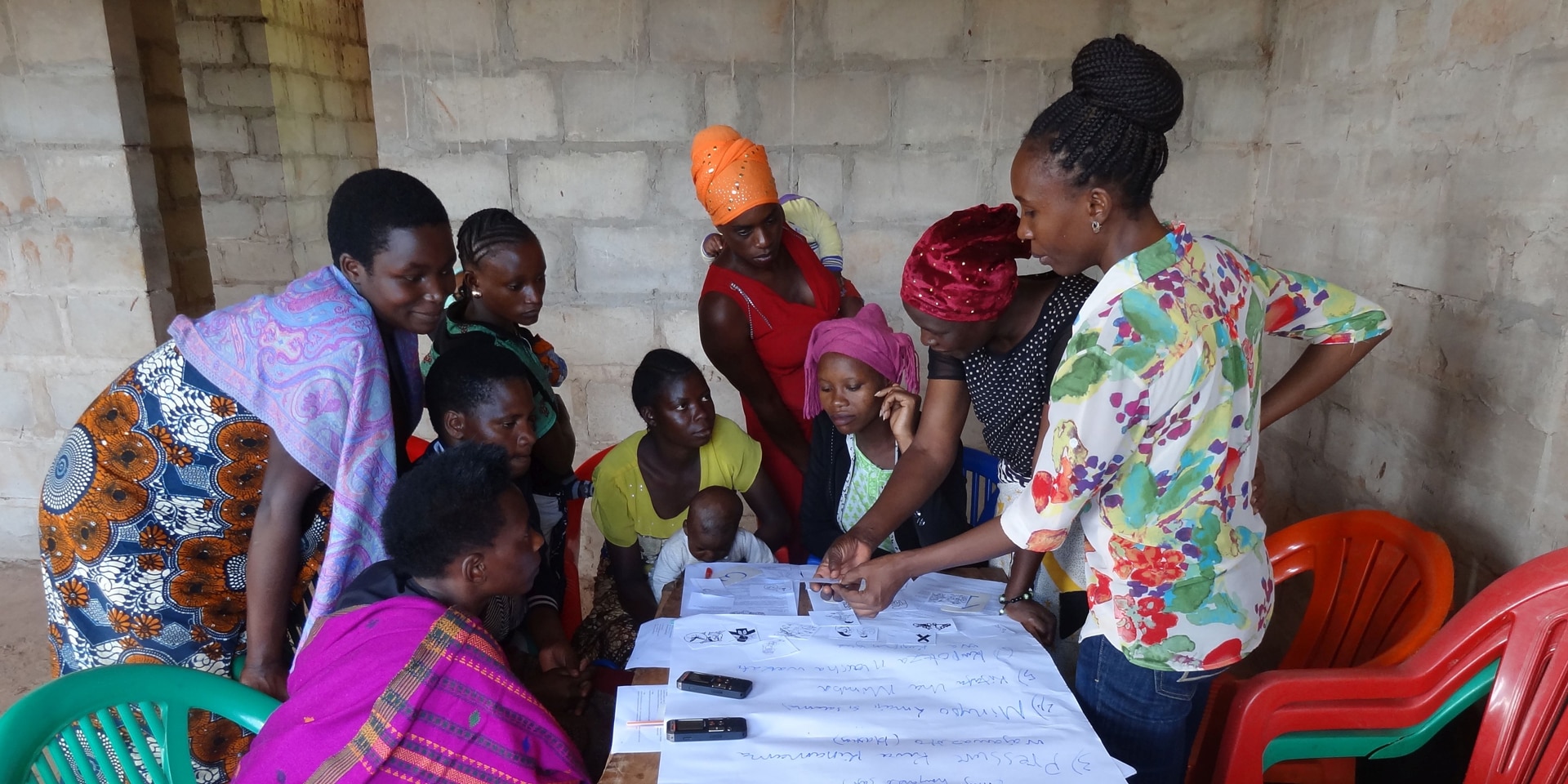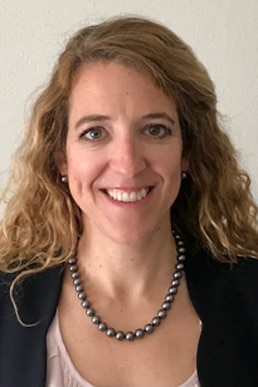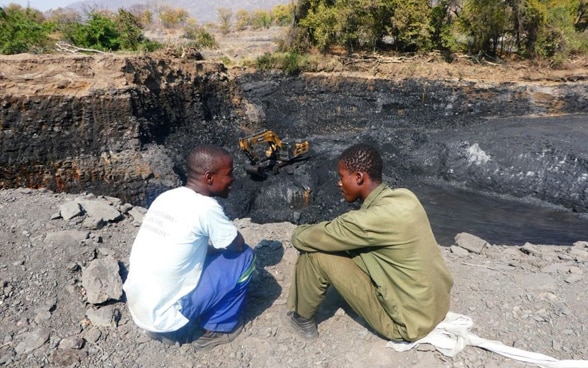Development cooperation and research: a promising model
The Swiss Programme for Research on Global Issues for Development (r4d programme), run by the Swiss Agency for Development and Cooperation (SDC) and the Swiss National Science Foundation (SNSF), ended on 25 April 2024. Its completion was the occasion for the two institutions to launch the new successor programme, SOR4D, which also focuses on health, food security, social conflicts, ecosystems, work and income in developing countries. Odile Robert from the SDC offers insights into both the completed and successor programmes in this interview.

Group discussion with women living in proximity of an industrial gold mine in Tanzania. © SNSF
From 2012 to 2023, the r4d programme, run by the SDC and the SNSF, funded research partnerships between Switzerland and countries in Africa, Asia, and Latin America. These partnerships kick-started innovative initiatives and presented solutions that they then put on the political agenda. Many of the projects involved brought forth new knowledge and solutions that made a significant impact in the partner countries. With a total budget of CHF 97 million, the r4d programme supported 57 research projects in over 50 countries.

How did the Swiss Programme for Research on Global Issues for Development – the r4d Programme – come about a decade ago? What were the SDC's hopes for it?
The SDC and the SNSF have been in partnership for decades. They launched the r4d programme at the time when the Millennium Development Goals were giving way to the 17 Sustainable Development Goals (SDGs), amid negotiations for the 2030 Agenda. In addition to immense global challenges like the climate and biodiversity crises, the world was facing significant political upheavals such as the Arab Spring. There was also a sense of hope and new beginnings. The Paris Agreement was signed, the 2030 Agenda was adopted, and there were pushes for democratisation in many places. The SDC aimed to contribute directly to the achievement of the SDGs with its research programme. Together with the SNSF, the SDC launched the pioneering r4d programme, which was "ahead of its time", as a recent external evaluation confirmed. The European Union then started a similarly designed programme: Horizon Europe.
In which areas of development cooperation has the SDC been able to make particular use of research cooperation? Could you give us three examples of how the SDC has achieved its goals more effectively by using approaches or findings from the scientific community?
Within the r4d programme, projects were implemented in the areas of health, food security, social conflicts, ecosystems, work and income. Innovative initiatives were launched, evidence-based solutions presented and put on the political agenda, and anchored locally, nationally or globally. Many of these projects brought forth new knowledge and solutions that have not only shaped the SDC's work but also been effective in its partner countries. Here are a few examples:
- Vocational education and training to create jobs in Nepal: A research project in Nepal looked at how the Swiss vocational education and training system can be used in low-income countries. A gap was identified between basic education and the requirements of the labour market. A new master's degree programme was created to close this gap. The knowledge transfer involved has also helped to reform policies in this area and improve many young people's prospects of finding better work.
- Sustainable building material made from coconut fibres in the Philippines: As part of an r4d project, a sustainable building material made from coconut fibres, or coir, was developed to counteract large-scale deforestation in the Philippines and at the same time create affordable housing. Called Cocoboards, these innovative and 100% organic panels are made from coconut husks and set to be 10–20% less expensive than the cheapest wood available in the Philippines. The r4d project helped young inventors to develop a sustainable Cocoboards business. There are plans to expand the supply chain in order to commercialise these panels and expand into other countries. This is the first such industrial use of coir to date.
- HIV prevention and treatment in Lesotho: In Lesotho, the percentage of adults living with HIV is still 25%. Access to testing and treatment is a major challenge for people living in rural, remote regions. As part of an r4d project, over 10,000 people were tested for HIV through a targeted door-to-door campaign, and medication was provided. An HIV database was set up and the local health infrastructure was expanded. In addition, with the researchers' findings having been successfully integrated into the national health strategy and incorporated into the WHO guidelines in this area, the research project from Lesotho is having an impact far beyond the country's borders.
- Sustainable cement production in India and Cuba: As part of r4d research, the Swiss Federal Institute of Technology Lausanne (EPFL) tested and adapted a clay-based cement compound. This compound now serves as the standard for cement production worldwide. The standard in place for cement production in Europe, the US, Cuba and large parts of South America and India was adapted based on this research's findings. This furthers SDG 13 by cutting emissions significantly, as cement production accounts for between 5% and 8% of global emissions worldwide. Holcim too now uses this type of cement. Karen Scrivener, head of the EPFL project, was recently appointed by the UN secretary-general to the Group of Ten High-level Representatives to promoted science, technology and innovation for the SDGs.

What does the cooperation between research and science look like up close? Does the SDC formulate project goals, with the scientific community then looking for ways to achieve them using innovative approaches? Or does the SDC seek out trends identified by or the results of research by the scientific community that could be of use for SDC projects?
The latter. Switzerland has a long-standing tradition of freedom of scientific research. The SDC and the SNSF determine the thematic areas and set the framework conditions. The researchers are free to decide in which countries of the Global South and in which areas they wish to conduct research. All projects are then subjected to a strict, SNSF-governed evaluation process.
The SDC's research programme allows innovative approaches and knowledge to be generated and tested. Innovation is always associated with greater risk, as not everything can be planned and the desired results may not be achieved. Experience has led the r4d programme to attach great importance to communicating and conveying research results in an understandable way, and it is essential to make these results accessible to the public at large (open source).
How many projects did the SDC support with research partners as part of r4d?
The r4d programme saw the SDC and the SNSF support a total of 57 research projects in over 50 countries. Partnerships and networks between Switzerland and the Global South that are still active today emerged from these projects. As in the examples above, many of these projects have found follow-up funding or are now being continued within a different framework.
In addition to the projects' specific results, an important contribution of r4d was to strengthen the capacities of researchers from the Global South and North. Through the r4d programme, more than 200 up-and-coming scientists were trained in international research settings and, according to an external evaluation, participation in the programme had a positive impact on the career development of over 90% of project participants from the Global South.
What have you and the SDC seen in terms of the way science addresses the thematic areas of the r4d Programme? Can you also leverage these insights beyond the given research cooperation project?
Many r4d projects were so promising that they are being continued. For example, a project in Kenya identified measures to contain invasive plants that siphon off precious water from the soil and harm farmland and livestock. This project led to a national strategy, adopted by the government, for the eradication of invasive trees in Kenya.
We have found that research collaboration on an equal footing and in particular the joint conceptualisation of research proposals help make projects a success. Switzerland's significant North-South research community relies on suitable funding opportunities, such as the r4d programme or its successor, the Solution-oriented Research for Development (SOR4D) programme. There is for example a lively exchange with the Commission for Research Partnerships with Developing Countries (KFPE), which helps to align the SDC-SNSF research programmes with the needs of researchers. This allows us to expand our reach effectively.
Have you received feedback from the SNSF as to what kinds of impetus working with the SDC has lent to the research and scientific community?
r4d was a partnership-based programme between the SDC and the SNSF, with both institutions bringing their respective expertise to the table: the SDC in the area of sustainable development cooperation and the SNSF in research. Neither institution would have been able to run this programme on its own. That makes the programme unique.
r4d and SOR4D are the only SNSF programmes aimed directly at sustainable development. In addition, the r4d Programme was a living lab that generated learnings for transformative research as it evolved over the years. The r4d and SOR4D programmes afford the SNSF opportunities to develop and test innovative research funding programmes. Such programmes provide deep wells of learning, particularly in the area of transdisciplinary cooperation between researchers and practitioners.
r4d is now giving way to the Solution-oriented Research for Development (SOR4D) programme. To what extent does the SOR4D programme stand in continuity with its predecessor, and how does it differ?
While building on the insights gained from r4d, the SOR4D programme focuses to an even greater extent on the actual impact in the partner countries. The difference is that SOR4D is no longer "only" interdisciplinary, but also transdisciplinary. Transdisciplinary means that interdisciplinary research collaboration is complemented by collaboration with actors from outside the scientific community. The aim is to facilitate learning processes between science and society in order to generate knowledge and solutions that can help to better cope with, overcome or prevent societal challenges. Accordingly, SOR4D focuses even more strongly on concrete solutions and the potential for upscaling, i.e. implementing or applying research findings outside of science.
SOR4D is, as the name suggests, solution-oriented. Does that mean that r4d was not solution-oriented enough? Why is the focus put on this so explicitly now?
We have gone one step further with SOR4D. While r4d already brought forth significant solutions, SOR4D is focusing even more strongly on the on-the-ground impact of the solutions developed. This makes it necessary to involve practitioners such as NGOs, local decision-makers and private-sector representatives early on. The aim is to ensure that the knowledge or solutions generated are incorporated into policy or taken up by NGOs or the private sector. It is also important to make sure that the projects adopt a systemic, i.e. holistic, approach so that the research can actually make an impact. Involving the local population and local stakeholders is a key element in making the projects successful and impactful. SOR4D is one of Switzerland's most competitive research programmes: only 8 of the 95 pre-proposals submitted were selected. This also highlights both the great interest in the programme as well as the significance of research for sustainable development.
